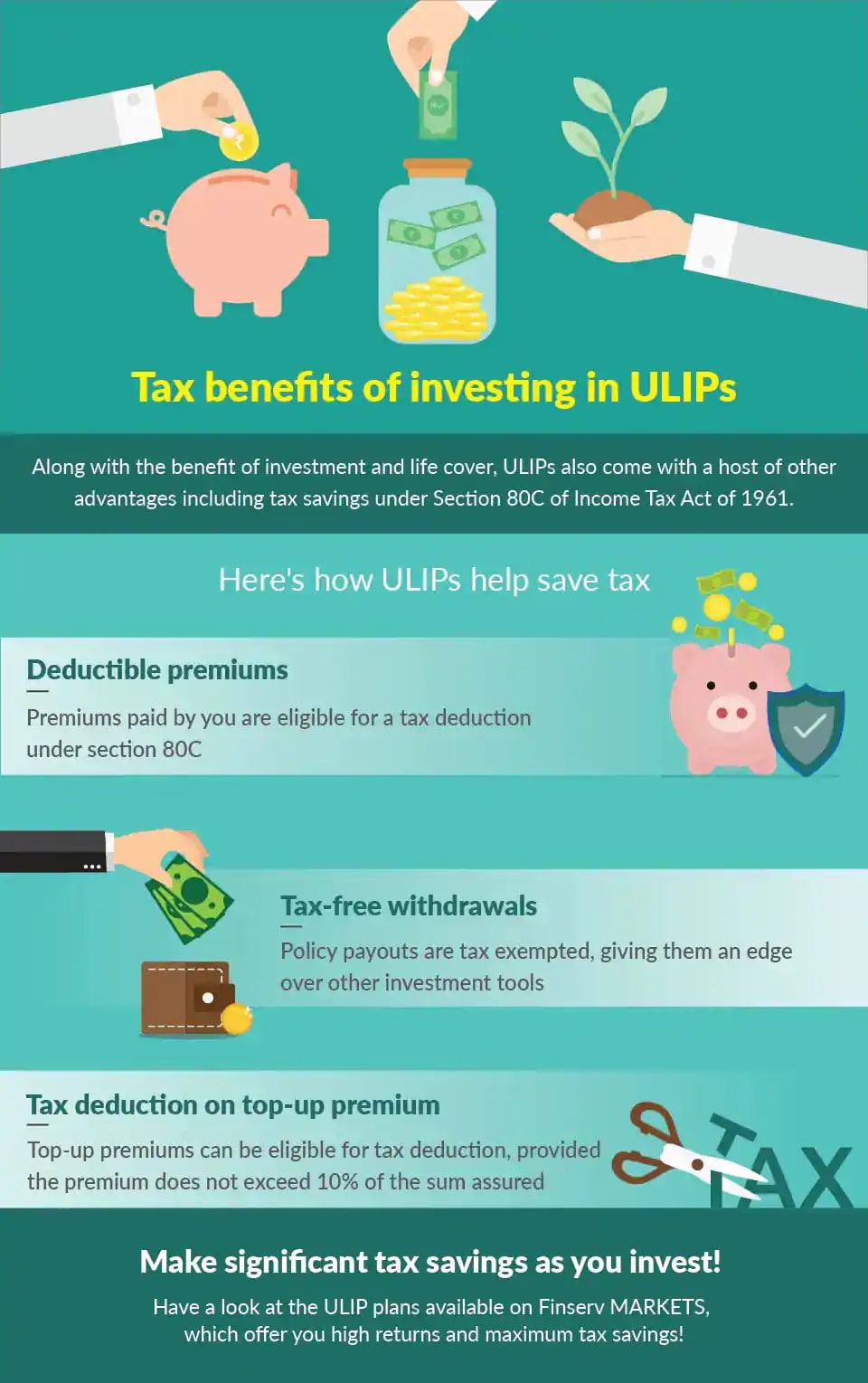A Unit Linked Insurance Plan or ULIP refers to an insurance product that is a combination of a life insurance plan, as well as an investment. As a ULIP investor, you must make regular premium payments – as one segment of your premium goes towards life insurance and the other gets pooled with assets from the larger subset (are invested in equity and debt financial instruments). This form of investment secures your future by allowing you to grow your corpus of funds while also securing you in case of emergencies.
Tax Benefits of Investing in ULIPs
The tax benefits associated with investing in ULIPs are as listed below:
Tax Benefits on Premiums
Any premium you pay for your ULIP plan enables you to avail of tax deductions of up to Rs. 1.5 Lakhs, under section 80C and section 10D of the Income Tax Act. To enjoy these ULIP plan tax benefits, it is essential that you continue your ULIP plan for at least five years.
Tax Benefits on Maturity
A unique feature of this form of investment is that no tax is imposed even on maturity. Thus, ULIP plans tax benefits range over the premium paying period, as well as on maturity, allowing you to save both ways.
Tax-Free Withdrawals on Death
In the case of death of the policyholder, the family will receive an assured amount, as well as any returns generated on the ULIP plan, exempted from any income tax deductions.
Tax-free Partial Withdrawals
Post the five-year lock-in period, if you decide to withdraw an amount less than 20% of the total corpus, it remains tax-free, with no deductions.
Deductions on Top-ups
Over the course of your plan, you have the option to increase your investment amount periodically, utilising top-ups. ULIP tax exemptions apply here, under sections 80C and 10D of the Income Tax Act.
Long Term Tax Benefits
Given that the minimum lock-in period for ULIPs is five years, you stand to gain ULIP tax benefits for a minimum of five years. As the investment horizon increases, so do your tax savings.

Exempt-Exempt-Exempt Tax Category
ULIPs fall under the Exempt-Exempt-Exempt tax-saving category, which refers to investments that benefit at the following three stages:
Investment phase
It’s the initial phase, when you start investing your funds in the instrument, in this case, tax saving ULIPs.
Accumulation phase
Through the gestation period of your investment, your funds generate dividends routinely, which are also tax-exempt.
Withdrawal phase
At the end of the investment period, you can withdraw the corpus of funds, with the lumpsum amount remaining tax-free in this case.
New Regime for the Taxation of ULIP after Budget 2021
The Union Budget of 2021 prescribed specific changes to the Income Tax Act of 1961. As per the latest amendments, any gains earned from tax-saving ULIPs will be considered capital gains if and when the premium amount exceeds Rs. 2.5 Lakhs and will then be taxed at 10% at the date of maturity. In addition to this, the latest amendment states that when redeeming a ULIP, a Security Transaction Tax (STT) will also be levied. To sum up, a ULIP will now fall under the same category as other equity investments, under section 111A and section 112A, during sale or redemption. However, these changes are only applicable for any ULIP plans purchased after the 1st of February 2021.
How does ULIP Taxation Work Now?
ULIP taxation, as per current norms, works in the following manner:
Taxation As Per Funds
The ULIP tax deduction on your investment will be proportional to the funds chosen and the proportion selected. If your equity portion is more significant than 65%, it will be taxed as an Equity Fund. In case of an indirect equity fund, i.e., in the form of an ETF, the equity portion should be at least 90%, to be taxed as an Equity Fund. Any Equity Fund investment over and above Rs. 1 Lakh will be subject to taxation. As per section 112A, a 10% tax rate is imposed for any profits arising from units of Equity Oriented Funds. As per section 112, a 20% tax rate is charged for any profits arising from Units of Debt Funds.
Exemption Under Section 80C
As per section 80C of the Income Tax Act, you can avail of deductions of up to Rs. 15 Lakh, keeping in mind that the premium paid by you is less than 10% of the sum assured, if in case the policy has been purchased after 1st April 2012.
Tax Benefits Other Than Section 80C
The returns generated will be tax-free if the premium you've paid is less than Rs. 2.5 Lakh, under section 10 (10)D – for any amount higher than this, taxes will be levied.
Maturity Taxability for ULIPs before 1st February 2021
The ulip tax on maturity is exempted, as per section 10 (10D), if the premium you pay is less than 10% of the sum assured at maturity and in the case of premiums purchased before April 2012, the rate stands at 20%
Maturity Taxability for ULIPs on/after 1st February 2021
If the premium paid by you per year is above Rs. 2.5 Lakh, the returns will be taxed. Additionally, ULIP gains will now be charged as Capital Gains, and if the rate of return exceeds Rs. 1 Lakh, the tax charged is pegged at 10% for equity investments and 20% for other forms.
Quick Recap on ULIP Tax Benefits

Let us proceed to understand the eligibility and documents needed when buying ULIP at Bajaj Markets.
Specifications of Tax Benefits (under Section 80C,80CCC and section 10(10D))
Section 80C
ULIP tax benefits fall under the purview of section 80C of the Income Tax Act, and you can enjoy a tax deduction of up to Rs. 1.5 Lakh provided the premium paid is less than 10% of the sum assured.
Section 80CCC
ULIP tax exemptions are also covered under section 80CCC of the Income Tax Act – specifically, you can claim up to Rs. 1.5 Lakh of the amount invested per financial year.
Section 10(10D)
On partial withdrawal or maturity, the amount received is tax-exempt if the premium payable is not more than 10% of the sum assured, and for policies purchased before 1st April 2012, this figure should not exceed 20%.
In a Nutshell
ULIPs are a great form of investment, offering protection in case of emergencies and exponential growth of one's corpus, along with ulip plan tax exemptions, making them a must-have in your portfolio.
ULIP Top Pages
- Advantages of Investing in ULIP
- Balanced funds
- Bond Funds
- Fund Switching Techniques
- Lock in period in ULIPs
- Mortality charges in ULIPs
- Myths about ULIPs
- Things to consider before buying ULIPs
- ULIP vs Mutual Funds
- ULIP vs PPF
- ULIP vs SIP
- What is ULIP?
- Why invest in ULIPs?
- Type 1 and Type 2 ULIPs
- ULIP vs ELSS
- Pension Calculator
- Ulip Charges You Must Know
- Pension Plan Guide
- Retirement Calculator
- ULIP Fees & Charges
- Types Of ULIP
- ULIP Quote
ULIP in Depth
- How to make a personalized investment plan
- How to choose the best ULIP plan
- Importance of Asset Allocation
- ULIP charges you should know
- Ultimate guide to ULIPs
- Importance of market linked instruments
- Evolution of ULIPs
- All about Endowment Plans
- ULIP NAV and its calculation
- Benefits of LLG
- ULIP FAQs
- ULIP fund performance
- Long Term Capital Tax on ULIPs
- Features and Benefits of Child ULIPs
- ULIP as an Investment Option
- How To Invest In ULIP At Low Costs
- Young Professional Guide To Investing In ULIP
- Benefits Of Online ULIPs Over Offline Ulips
Government Investment Schemes
FAQs On ULIP Tax Benefits
When should I invest in ULIPs?
There is no specific time to invest in a ULIP. However, to avail ulip plan tax exemptions people tend to invest in them during the tax paying season.
What is NAV?
Net Asset Value (NAV) refers to the total value of units held, minus liabilities.
How to calculate ULIP Fund Value?
The fund value can be calculated by multiplying the net asset value of each unit on the day by the number of units.
What is the lock-in period?
The lock-in period is five years.
Will I have to pay tax on maturity?
As per the Budget 2021, ULIP plans with annual premiums over Rs. 2.5 Lakh are not tax-exempt.
Happy Customers of Bajaj Markets
Enter Your OTP








